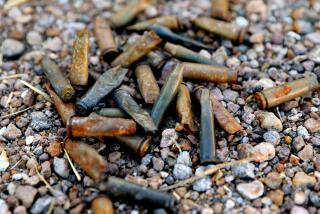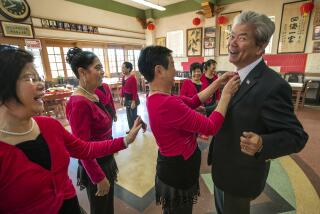Crime Gangs Known as Triads Are a Fact of Life in Hong Kong
- Share via
HONG KONG — With their roots in 17th-Century China and their branches reaching into every walk of life, the Hong Kong crime gangs called triad societies are casting shadows that extend farther and farther from the British colony.
Founded as a patriotic society pledged to drive the Manchu conquerors out of China in the 1600s, the triads once played a key role in the rise to power of Chinese Presidents Sun Yat-sen and Chiang Kai-shek.
Today, the triads control and oversee an organized crime network that specializes in drug trafficking, extortion, loan sharking, gambling and prostitution and have activities in virtually every Chinese community around the globe.
With communist China scheduled to take control of Hong Kong when the British lease expires in 1997, there are fears--expressed chiefly by the United States, Canada and Australia--that the gangs will transplant their operations abroad.
Seen as a Menace
Hong Kong police say there is no evidence that is happening, but concede that Chinese gangsters have traveled abroad, carrying their arcane traditions and practices with them, since the first great wave of migration from China to San Francisco and Australia in 1840.
“Triads are a menace in two main ways,” said a recent government report.
“As far as the general public is concerned, it is the gang activity, the threatening behavior, the assaults, the intimidation and the blackmail that are most worrying. But triads are also deeply involved in organized crime: drugs, gambling, vice and protection rackets.”
Police refuse even to guess how many members belong to the 50 to 60 separate triad societies now active among Hong Kong’s 5.5 million people, but as recently as 1960 it was estimated that one in every six residents belonged to one.
More Than 100,000 Members
“The total is certainly in excess of 100,000, ranging from youth gangs of 12 or 13 members to full-fledged organized crime groups,” said Detective Chief Superintendent Brian Merritt, who directs a 460-man task force fighting organized crime. “It’s far too many for our liking.”
One triad alone, the Sun Yee On, is estimated to have more than 30,000 members.
The roots of the societies are tangled in Chinese history. They began to take recognizable shape as a resistance movement to the Ch’ing Dynasty, the Manchu conquerors who overthrew the Chinese Ming in 1644 and held power until this century.
Members of the society’s 2nd Lodge, active in south China, appeared in Hong Kong soon after the barren island was first settled by British opium traders, and turned quickly to organizing criminal activity among the coolies and carriers.
Laws Have Been Ineffective
The first anti-triad ordinance was passed in 1845, just three years after the founding. It was ineffective in halting the triad activities, as have been all efforts since.
Attempts to penetrate the triads, which take the name from their three-sided sacred symbol representing heaven, Earth and man, have been frustrated by the groups’ arcane rituals and a code of secrecy that would make the Mafia blush.
“I shall never betray my sworn brothers,” says one of the 36 oaths that every new member must take. “If, through a misunderstanding, I have caused the arrest of one of my brothers I must release him immediately. If I break this oath I will be killed by five thunderbolts.”
The initiation ceremony, once a three-day affair, has been reduced to little more than half an hour, according to Merritt, but much of the ceremony has been preserved and triad officers still use such colorful titles as “Red Pole” (fighter), “White Paper Fan” (adviser), and “Grass Sandal” (messenger).
Inevitable Glamour
The rich traditions invite comparisons to the Masonic society in the West and lend an inevitable glamour to the triads, which is galling to their enemies such as Hong Kong’s principle assistant secretary for security, Michael Stone.
“It may seem romantic but that really is not true,” Stone said. “They are just a bunch of thugs like the Mafia. They use these rituals to bind themselves together and to instill fear in the local people.”
So strong is the fear the triads are able to command that Hong Kong has made it a crime merely to claim membership in a society.
“When an individual says he is part of the 14-K (a major triad), people have the idea that he may be able to call upon a large powerful organization, so young, puny thugs can extort money in this way,” Stone explained.
Organized Monopolies
Besides the usual organized crime activities--drug-running, extortion and prostitution--the triads have organized monopolies enabling them to extract “squeeze” money from street vendors, truck drivers and a host of other tradesmen.
When a cross-harbor tunnel was built linking Hong Kong Island to the mainland, there were several weeks of gang fights as the triads battled to see who would control drivers running buses through the tunnel, Merritt said.
“The drivers had to pay an initiation fee, but afterwards they were happy about it because their jobs were protected and no one could break their iron rice bowl,” he said.
Gang violence is vicious but seldom deadly, in part because of Hong Kong’s strict ban on the private possession of firearms. That leaves metal pipes and fierce-looking meat cleavers called “choppers” as the weapons of choice.
Prosecution Difficult
“A lot of the choppings are intergang activities--it is not that often that someone not involved in triad activity is chopped,” Stone said. Such choppings are usually not deadly, he added, “but limbs are sometimes badly damaged.”
While the pattern of criminal activities resembles that of the Mafia in many respects, Merritt was at pains to point out major structural differences that make prosecution of the triad leaders more difficult.
“Triad societies in Hong Kong are not organized crime syndicates,” he said. “They are totally different from the Mafia in that the top guys are often not involved in organized crime at all.”
While the senior triad leaders arbitrate disputes and receive “gifts” from society members, middle level officers may run their own criminal enterprises with no need to report to the chairman or “dragon head,” Merritt explained.
Protection of the Triad
Within the ring running that criminal activity there may be members of other triads or people who are not triad members at all.
Nevertheless, membership in the triad provides a member with the protection of the society and access to people and activities with whom they can form criminal ventures, he said.
“Abroad you have a subtle difference,” Merritt continued. “If you have only got 50, say, 14-K members in Seattle, it may well be they will form one gang called the 14-K and go directly into organized crime. So the society abroad may be an organized crime syndicate, but that is not the case in Hong Kong.”
Four triad groupings initially came to Hong Kong in the 1840s and they all reported back to Canton, seat of the 2nd Lodge of the original society that governed southern China.
“They quickly realized there was a fortune to be made organizing labor, the waterfront, coolies, whatever,” Merritt said. “Almost a second government was formed.
Money Splintered Society
“The branch heads soon realized they didn’t need to send the money back to Canton and they broke away and splintered. So within about 50 years there were 50 to 100 societies; money was the thing that broke up the triad society in Hong Kong.”
The same pattern held with the arrival after China’s communist revolution of the 14-K, which takes its name from the street address of its former headquarters in Canton and is now perhaps the best known of all the triads.
The 14-K, originally formed by the Nationalist Chinese government of Chiang Kai-shek as a militia to resist Mao Tse-tung’s Red Army, fled to Hong Kong before the communist wave and quickly splintered into 44 factions, about half of which are still active.
“Some North American police forces have only heard of the 14-K so they think all Chinese crime gangs are the 14-K,” Merritt said. “But in Hong Kong it is not one society. There are about 20 groups left and they are in conflict with each other.”
Crackdown in 1970s
Efforts to control the gangs over the years were complicated by triad penetration of the police force and government, a problem that was addressed in the mid-1970s with the creation of a powerful autonomous body called the Independent Commission Against Corruption (ICAC).
“The police force here started cracking down on corruption in the late 1960s and 1970s,” said Merritt, “and then the ICAC was formed and a lot of the organized crime characters decided they had better change their methods because the protection wasn’t there.
“There were quite a few senior detectives and sergeants who decided to get out of Hong Kong. Some of these were very rich, very powerful. . . . There is no doubt we have broken up syndicated corruption on the scale it used to be.”
There are probably still triad members in the police, Stone admitted, “but the officers are vetted carefully and . . . the higher they rise, the more carefully they are watched. So the chances of large numbers of them being in the force, it is fair to say, are fairly small.”
More to Read
Sign up for Essential California
The most important California stories and recommendations in your inbox every morning.
You may occasionally receive promotional content from the Los Angeles Times.










